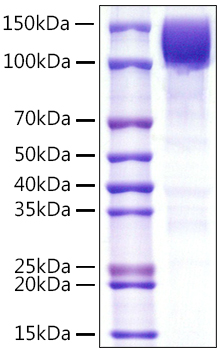Description
Recombinant Human PTPRC/CD45RA/CD45 Protein
The Recombinant Human PTPRC/CD45RA/CD45 Protein is a biologically active recombinant protein that plays a significant role in various cellular processes and signaling pathways in human biology. This protein is widely employed in immunological research, cell biology studies, protein-protein interaction analyses, and therapeutic development, providing researchers with a reliable tool for investigating PTPRC/CD45RA/CD45 function and its implications in health and disease.
This product (SKU: RPCB1263) is produced using HEK293 cells and features a C-Rabbit Fc tag for convenient detection and purification. The protein exhibits a calculated molecular weight of 76.96 kDa with an observed molecular weight of 100-150 kDa under denaturing conditions, achieving ≥ 95 % as determined by SDS-PAGE., ensuring exceptional quality and consistency for research applications.
Key Features
| High Purity by Affinity Chromatography | |
| Mammalian & Bacterial Expression Systems | |
| High lot-to-lot consistency via strict QC |
| Product Name: | Recombinant Human PTPRC/CD45RA/CD45 Protein |
| SKU: | RPCB1263 |
| Size: | 10 μg , 20 μg , 50 μg , 100 μg |
| Reactivity: | Human |
| Synonyms: | B220, CD45, CD45R, GP180, L-CA, LCA, LY5, T200, PTPRC, B220, CD45, CD45R, GP180, L-CA, LCA, LY5, T200, receptor-type tyrosine-protein phosphatase C |
| Tag: | C-Rabbit Fc |
| Expression Host: | HEK293 cells |
| Calculated MW: | 76.96 kDa |
| Observed MW: | 100-150 kDa |
| Gene ID: | 5788 |
| Protein Description: | High quality, high purity and low endotoxin recombinant Recombinant Human PTPRC/CD45RA/CD45 Protein (RPCB1263), tested reactivity in HEK293 cells and has been validated in SDS-PAGE.100% guaranteed. |
| Endotoxin: | < 0.1 EU/μg of the protein by LAL method. |
| Purity: | ≥ 95 % as determined by SDS-PAGE. |
| Formulation: | Lyophilized from a 0.22 μm filtered solution of PBS, pH 7.4. |
| Reconstitution: | Centrifuge the vial before opening. Reconstitute to a concentration of 0.1-0.5 mg/mL in sterile distilled water. Avoid vortex or vigorously pipetting the protein. For long term storage, it is recommended to add a carrier protein or stablizer (e.g. 0.1% BSA, 5% HSA, 10% FBS or 5% Trehalose), and aliquot the reconstituted protein solution to minimize free-thaw cycles. |
| Storage: | Store at -20℃.Store the lyophilized protein at -20℃ to -80 ℃ up to 1 year from the date of receipt. After reconstitution, the protein solution is stable at -20℃ for 3 months, at 2-8℃ for up to 1 week. |
The cluster of differentiation (CD) system is commonly used as cell markers in Immunophenotyping. Different kinds of cells in the immune system can be identified through the surface CD molecules associating with the immune function of the cell. There are more than 320 CD unique clusters and subclusters have been identified. Some of the CD molecules serve as receptors or ligands important to the cell through initiating a signal cascade which then alter the behavior of the cell. Some CD proteins do not take part in cell signal process but have other functions such as cell adhesion. Protein tyrosine phosphatase, receptor type C (CD45), also known as PTPRC is a member of the protein tyrosine phosphatase (PTP) family which is known for its function to serve as signaling molecules and to regulate a variety of cellular processes such as cell proliferation, differentiation, mitotic cycle and oncogenic transformation. CD45 is found expression specifically in hemotopietic cells. CD45 consists of an extracellular domain, a single transmembrane segment and two tandem intracytoplasmic catalytic domains. It serves as an essential regulator of T-cell and B-cell antigen receptor signaling through either direct interaction with components of the antigen receptor complexes or by activating various Src family kinases required for the antigen receptor signaling and it also can suppress JAK kinases.







